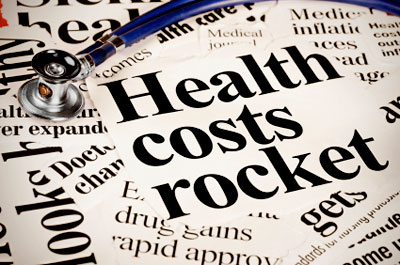|
from DrSircus Website
Fidelity Investments, which oversees some 12 million 401(k) accounts, has a study saying that an average 65-year-old couple retiring in 2012 would need to have $240,000 in savings to pay for out-of-pocket health-care costs in retirement.
And that’s $240,000 in today’s dollars, so a couple retiring in 10 years would need the inflated-adjusted equivalent in the year 2022. (In its 11 years of doing this study, Fidelity has found the rate of health-care inflation to average 6% per year; assuming that rate stayed constant, a 2022 retiree would need about $430,000 set aside.)
With 50 million people on food stamps I wonder how many Americans are going to have this kind of money. The cost of choosing the wrong medicine is not only expensive but it can also cost a person their life.
Forbes Magazine writes,
Most of the Natural Allopathic Medicine protocol is also injectable (though we prefer to use transdermal and oral methods whenever possible) as well as useable through feeding tubes, suppositories and nebulizers, which most injectable biotech drugs are not.
Dr. Leslie S. Wilson, at the School of Medicine, University of California, compared costs of all prostate-related treatments over five-and-a-half years of 4,553 newly diagnosed men stratified by age, risk, and ethnicity.
In the first six months, the mean cost after treatment was $11,495 and was directly impacted by treatment type. Cost ranged from only $2,568 for watchful waiting (by 2010 that cost was estimated to be $6,558 to $11,992) to $24,204 for external beam radiation.
Subsequent annual cost was found to average $7,740 and ranged from $5,843 for watchful waiting to $12,590 for androgen deprivation therapy. Cumulative mean cost over 5.5 years for all risk groups was $42,570, with watchful waiting costing the least at $32,135 and androgen deprivation therapy costing the most at $69,244.[1]
Researchers from Harvard University, National Cancer Institute, and National Bureau of Economic Research published in the December 1, 2007 issue of Cancer findings that the average life-expectancy for lung cancer patients raised by less than one month between 1983 and 1997, while costs rose by over $20,000 per patient.
Cost effectiveness, as measured by the cost of an additional year of life gained, was poor, with a high average cost of $403,142.
When analyzed by disease severity, the cost per additional year gained for local and regional disease was $143,614 and $145,861, respectively. For metastatic cancer, the cost per additional year gained was $1,190,322.[2]
There’s a dramatic increase in the cost of the new drugs. And there’s a shift by doctors to newer drugs that are substantially more expensive. – Dr. Len Lichtenfeld Editor for the American Cancer Society
Even patients with insurance are thinking hard before agreeing to treatment because out-of-pocket copayments for drugs that could easily run $10,000 to $20,000 a year. One of the few cancer drugs with a higher monthly price tag than usual is Erbitux. The drug, used for colon cancer, sells for $9,600 monthly.
But don’t tell anyone that a late-stage clinical trial in advanced stomach tumors failed to show that Erbitux had any significant benefit in progression-free survival. It is the second blow for Erbitux in 2012.
Back in May Merck said there was no additional benefit when [Erbitux was] given with chemotherapy to colon cancer patients after surgery to remove their tumor. In December of 2012 the company got bad news about its innovative new lung cancer drug Stimuvax, which did not improve the overall survival of patients at all in its phase III study.
Also in December a major trial of Merck & Co. Inc.’s Tredaptive medicine to increase “good” HDL cholesterol has raised safety concerns and showed it was no better at preventing heart attacks, deaths or strokes than traditional statin drugs that lower “bad” LDL cholesterol, the company said.
Most pharmaceuticals are junk medicines like this. Today we have to consider ourselves lucky if our prescribed medications don’t kill us. Now they even have shortages of key drugs and have to offload patients to less effective or more dangerous medicines.
With Obama care coming down the road doctors are also threatening in in America to quit and even if a small percentage do it will mean much longer lines for less effective care.
The Cost of Doing Nothing
In modern oncology the cost of doing nothing is actually quite expensive.
Active surveillance is a reasonable option for men with slow-growing cancers because it is not known whether treating the cancer with surgery or radiation will actually help them live longer. These treatments have definite risks and side effects that may outweigh the possible benefits for some men.
Costs still range from $6,558 to $11,992 a year if one is under the care of an oncologist.
The Natural Allopathic Medicine protocol that I have developed is effective for most diseases and at multiple income levels.
The first 4-5 components of the protocol give the lower-income or under-insured people of the world a fighting chance of recovering from cancer or other diseases. Cost to them could be as low as $250 a month or roughly $7.50 a day if they live in the third world, more of course for those in post-industrial societies.
Add low-cost walks in the sun, purified water and homegrown medical marijuana and one has a protocol that is infinitely more powerful than doing nothing. And in fact, treatments with concentrated nutritional medicines far surpass toxic oncology treatments with respect to a positive outcome without the risk of negative side effects that even oncologists fear.
I have written full-length books about four of these protocol medicinals, presenting the medical science and the clinical experiences of doctors from around the world who use them to treat cancer and other diseases.
Pharmaceutical Drugs Do Not Address the Cause of Cancer
Some of the most painful insurance-related horror stories involve patients suddenly being told that they need a drug that is astronomically expensive.
That’s what happened to Arlington’s Robert W. Banning, a chronic myelogenous leukemia victim who was prescribed Sprycel by his doctor. The twice-daily tablet inhibits the spread of cancer cells without the grueling ordeal of chemotherapy, but a 90-day supply costs a staggering $13,500, of which Banning’s AARP insurance required him personally to pay over $4,000.
None of these expensive drugs addresses the cause of any of the diseases they are designed to treat. They treat the symptoms, mostly shifting them around with resultant side effects that require other drugs in an ever-downward spiral to more suffering and pain, financial bankruptcy and eventual death.
All of the components of the Natural Allopathic Medicine protocol treat a cause of disease. To incorporate the full protocol we can estimate that it would cost $6,000 for a three-month treatment plan, which is necessary for late-stage cancers, though cancer can sometimes be cured in less time for less cost if a person has not been damaged by radiation, surgery and/or chemotherapy.
This would include all the medicinals (supplements selected from the best companies offering the best products) sustained at high dosage levels, super nutrition from diverse sources, full professional support through phone and text chat/ email, and an array of medical equipment.
At this cost level, the patient can afford some very interesting pieces of medical equipment/ healing devices that facilitate quicker and easier returns to health that are not employed by other protocols.
I like to include far-infrared sauna equipment, nebulizers, electro-magnetic technology that is FDA-approved for treating brain cancer and wounds, intense light and color therapies, breathing retraining devices (an important treatment component ignored by just about everyone), all of which can be included at this $6,000 level.
Unfortunately location means much in terms of access to certain medicinals and healing/ medical devices. In third-world countries only the most basic - but fortunately the strongest - medicinals in the protocol are available; often high import taxes are applied to anything that needs to be brought in quickly, adding to the expense.
Even in the first world, what might be available in Canada for $30 could be three times as much in the States because of the FDA and other factors.
I discuss the full protocol in my upcoming book, Natural Oncology - Anti-Inflammatory Cancer Therapy, but it is presented and described in Treatment Essentials, which is the practical manual for learning to treat cancer and other diseases in the safety and comfort of one’s own home.
This cost would not include massages (that can be done by a family member at home), home nursing support (that can also be provided by family), or other professional services or treatments.
Though one can spend considerably more on sophisticated equipment and employ a staff of healers and professionals like acupuncturists, homeopaths, chiropractors, colonic therapists, professional massage therapists, and even doctors, all of which we support from the platform of the 18th component of the protocol, Treatment Essentials gives you almost all the information you need to go it alone, though it is suggested that help/ support is crucial for optimizing the program according to the specific needs of the individual.
Comparing Natural Allopathic Medicine to Other Forms of Natural Medicine
The Gerson Institute and the Budwig Center are perhaps the best-organized and most prestigious natural medicine approaches building on decades of solid medical tradition and experience.
Like the Natural Allopathic Medical approach, both the Gerson and Budwig protocols can be done entirely from one’s own home. On the Gerson Therapy site they say,
The Natural Allopathic Medicine protocol offers flexibility, convenient options, a greater depth of documented scientific support, greater focus on reaching more deeply into cell physiology through more concentrated use of medicinals, thus faster healing times.
The superfood dietary component (one of eighteen components) of the Natural Allopathic protocol incorporates the knowledge and wisdom of both Dr. Max Gerson and Dr. Johanna Budwig.
The cost of natural therapies varies widely depending on the intensity level of treatment necessary.
According to the Budwig site, for late-stage cancer, the cost of treatment runs approximately $2,000-$2,500 per month with the duration of treatment lasting up to six months with depending on the severity of the cancer.
With the Gerson method, monthly costs are approximately $2,000 or more including equipment with treatment going on for two years. Both recommend attending their treatment centers before starting alone at home.
This is quite expensive but a good investment for anyone choosing those protocols.
Conclusion
Complicating our choices are financial realities. Some people destroy the lives of their entire family by taking on crushing debt.
Ellis Minrath, 87, declined to take a drug for pancreatic cancer partly because he would have to make a copayment of about $1,000 a month. When approaching treatment of cancer or anything else, a person must look at his financial situation and decide what he can afford.
If you have limited resources, you must cut to the chase and pick the most powerful but least expensive treatments, of which there are more than several.
If you are well off financially then the world can be yours in terms of natural oncology that offers some sophisticated healing machines. Instead of death rays found in the radiology departments, we can flood the tissues with light, heat and organizing frequencies that send FDA-approved healing energy directly into the heart of the cells.
I would like to conclude with the fact that you can do the protocol for almost nothing - or let’s say for a few hundred dollars. What I need to communicate here is that there are people, like Vernon Johnston, who cured himself of prostate and bone cancer with just baking soda and breathing retraining. In Russia doctors understand the importance of breathing in medicine.
The total cost to Vernon was less than $100!
It is truly amazing what one can add for just a few hundred dollars more.
References
|


